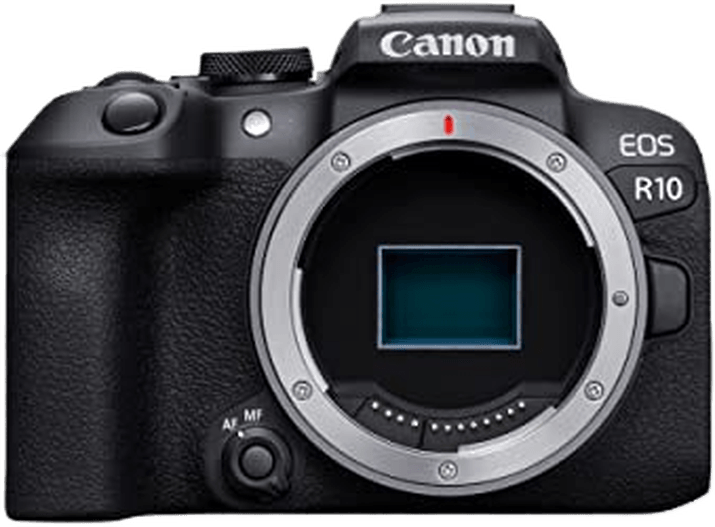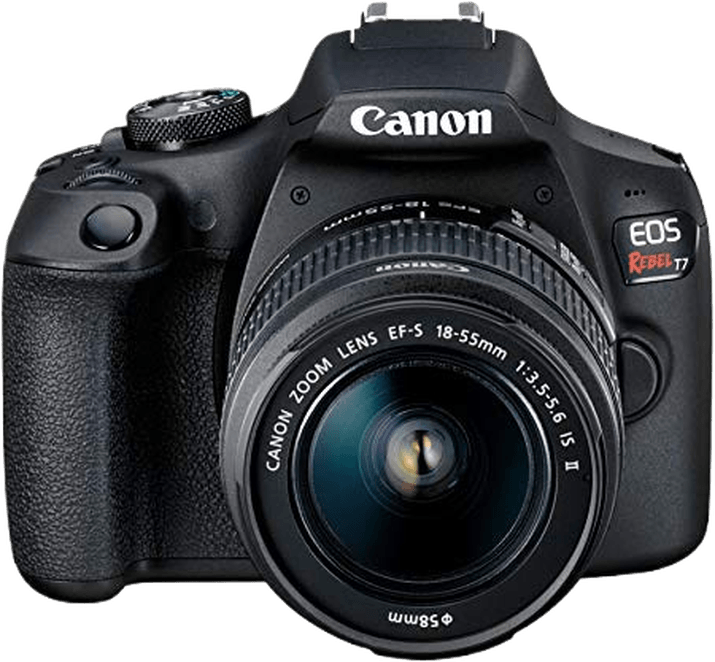Canon EOS R10 vs EOS Rebel T7 / 2000D Comparison
Canon EOS R10

Canon EOS Rebel T7 / 2000D

The Canon EOS R10 outperforms the Canon EOS Rebel T7 / 2000D with a 19-point difference in our scores, earning 69/100 and 50/100, respectively. Both cameras share common specifications such as their announcement years (R10 in 2022 and T7 in 2018) and launch prices ($980 for R10 and $550 for T7).
The EOS R10 excels as a mirrorless camera with a smaller size (123 x 88 x 83mm) and lighter weight (426g / 0.94lbs) compared to the Rebel T7’s DSLR design, size (129 x 101 x 78mm), and weight (660g / 1.46lbs). This makes the R10 more portable and user-friendly.
However, the Rebel T7 / 2000D holds an advantage in affordability with its lower launch price of $550, making it an attractive option for those on a budget.
Taking these factors into consideration, the Canon EOS R10 emerges as the superior choice for its compact design and lighter weight, while the Canon EOS Rebel T7 / 2000D may appeal to those seeking a more budget-friendly option.
Canon EOS R10 vs EOS Rebel T7 / 2000D Overview and Optics
The Canon EOS R10 outperforms the Canon EOS Rebel T7 / 2000D in optics with a score of 71/100 compared to 56/100. Both cameras share some common specifications, such as 24 and 24.1 megapixels, CMOS sensor type, APS-C sensor size, and the lack of image stabilization. However, there are key differences that make the R10 a superior camera in terms of optics.
The R10 has a faster shooting speed of 15 frames per second, which is significantly higher than the T7’s 3 frames per second. This means the R10 can capture fast-moving subjects more effectively. Additionally, the R10 is equipped with a Digic X processor, which is more advanced than the T7’s Digic 4+ processor. This results in better image quality and faster performance.
The R10’s sensor has a DXOMARK score of 97, indicating a higher image quality compared to the T7’s score of 71. Furthermore, the R10 uses the Canon RF lens mount, which allows for a wider range of high-quality lenses to be used with the camera. In contrast, the T7 uses the Canon EF-S lens mount, which has a more limited selection of lenses.
The T7 does have a slight advantage in megapixels, with 24.1 compared to the R10’s 24. However, this difference is negligible and does not significantly impact image quality.
Based on these factors, the Canon EOS R10 is the clear winner in terms of optics. Its faster shooting speed, better processor, higher DXOMARK score, and more versatile lens mount make it a superior choice for photographers seeking the best image quality. While the Canon EOS Rebel T7 / 2000D is still a decent camera, it falls short in comparison to the R10’s superior optics performance.
Canon EOS R10 vs EOS Rebel T7 / 2000D Video Performance
The Canon EOS R10 outperforms the Canon EOS Rebel T7 / 2000D in video capabilities, scoring 91/100 compared to the Rebel T7’s 43/100. Both cameras share some common specifications, such as their ability to record video and the presence of a built-in microphone for audio recording. However, the differences in their video performance are significant.
The EOS R10 boasts a higher maximum video resolution of 4K (3840 x 2160), while the Rebel T7 is limited to Full HD (1920 x 1080). This difference in resolution results in the R10 producing videos with greater detail and clarity. Additionally, the R10 has a higher maximum video frame rate of 120fps, which allows for smoother motion capture and the possibility of slow-motion playback. The Rebel T7’s maximum frame rate is only 30fps. Furthermore, the R10 features built-in time-lapse functionality, providing users with the ability to create stunning time-lapse videos without requiring additional equipment or software.
On the other hand, the Rebel T7 / 2000D does not have any clear advantages in video capabilities over the EOS R10. Its lower video resolution, reduced frame rate, and lack of time-lapse functionality make it a less capable camera in terms of video performance.
Taking these factors into account, the Canon EOS R10 is the superior camera for video recording. Its 4K resolution, higher frame rate, and built-in time-lapse functionality set it apart from the Rebel T7 / 2000D, which has more limited video capabilities. For users prioritizing video performance, the Canon EOS R10 is the clear choice.
Canon EOS R10 vs EOS Rebel T7 / 2000D Features and Benefits
The Canon EOS R10 is the clear winner in this comparison, with a feature score of 70/100, while the Canon EOS Rebel T7 / 2000D scores 41/100. Both cameras share some common features, such as a 3-inch screen size, flip screen, no GPS, and WiFi connectivity. However, the R10 outperforms the T7 / 2000D in several aspects, making it the superior choice.
The R10’s screen resolution is higher at 1,040,000 dots, compared to the T7 / 2000D’s 920,000 dots, ensuring better image clarity and detail. Additionally, the R10 has a touchscreen, which the T7 / 2000D lacks, providing users with a more intuitive and responsive interface. The R10 also comes with Bluetooth connectivity, enabling seamless pairing with compatible devices for quick media transfers and remote camera control.
In contrast, the T7 / 2000D has limited advantages over the R10. The only notable feature it shares with the R10 is the flip screen, which is useful for capturing images and videos from various angles. However, this alone is not enough to outweigh the R10’s superior features.
Considering the significant differences in feature scores and the various advantages offered by the R10, it is evident that the Canon EOS R10 is the better camera. Its higher screen resolution, touchscreen interface, and Bluetooth connectivity make it a more versatile and user-friendly option. The Canon EOS Rebel T7 / 2000D, while sharing some features with the R10, falls short in comparison and would not be the ideal choice for those seeking a camera with more advanced and convenient features.
Canon EOS R10 vs EOS Rebel T7 / 2000D Storage and Battery
The Canon EOS R10 outperforms the Canon EOS Rebel T7 / 2000D in storage and battery with a score of 40/100, while the latter scores 27/100. Both cameras share similarities in storage, as they each have a single memory card slot and accept SD, SDHC, and SDXC cards. However, the R10 has an edge with its UHS-I compatibility, allowing for faster data transfer and better performance.
In terms of battery life, the Rebel T7 / 2000D lasts slightly longer with 500 shots, compared to the R10’s 450 shots. Despite this, the R10 uses the LP-E17 battery type and offers USB charging, providing more convenience and versatility for users. On the other hand, the Rebel T7 / 2000D relies on the LP-E10 battery and lacks USB charging capabilities.
Considering the storage and battery aspects, the Canon EOS R10 proves to be a better choice due to its UHS-I compatibility and USB charging option. The Rebel T7 / 2000D, however, offers a marginally better battery life, which may be advantageous for some users.
Canon EOS R10 vs EOS Rebel T7 / 2000D – Our Verdict
Are you still undecided about which camera is right for you? Have a look at these popular comparisons that feature the Canon EOS R10 or the Canon EOS Rebel T7 / 2000D:
